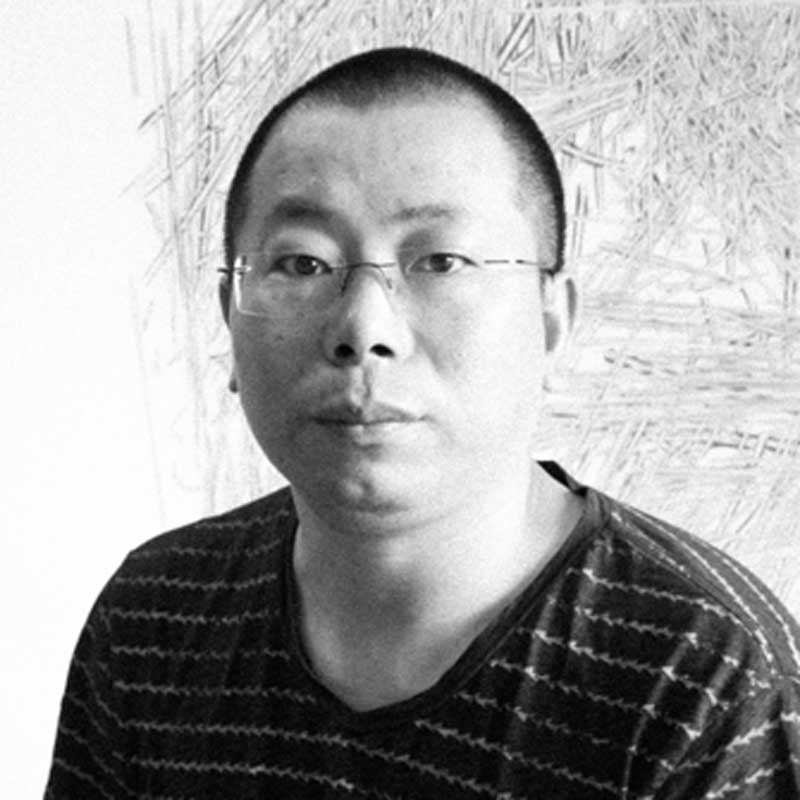教育 Education:
2014,毕业于首都师范大学获硕士学位,北京,中国
2000,毕业于天津美术学院中国画系,天津,中国
个展 Solo Exhibition:
2024,行星,HdM Gallery,北京,中国
2022,郝世明水墨展,法国亚洲协会,巴黎,法国
2019,繁生——郝世明作品展,湖北省美术院美术馆,武汉,中国
2019,郝世明|新水墨,La Forest Divonne 画廊,布鲁塞尔,比利时
2018,郝世明|出石,HdM 画廊,北京,中国
2015,郝世明|聚,Hadrien de Montferrand 画廊,北京,中国
2015,N.B.PROJECTS:郝世明个展,上品艺琅,北京,中国
2013,化——郝世明个展,美术文献艺术中心,武汉,中国
2009,郝世明作品展,艺术景中心,上海,中国
2008,郝世明个展,艺术景中心,上海,中国
群展 Group Exhibition:
2024,第十四届全国美术作品展览进京作品展,中国美术馆,北京,中国
2024,迭变·水墨当代的多元表达,嘉德艺术中心,北京,中国
2024,“字”得其乐,艺倡画廊,香港,中国
2024,第十四届全国美术作品展,广州美术馆,广东,中国
2024,再出发:零点艺术馆第二回展,零点艺术馆,武汉,中国
2024,承流会变 昙华林中国画创作群体研究展,湖北省美术院美术馆,湖北,中国
2023,中国当代水墨之变邀请展,隆福文化中心,北京,中国
2023,十五周年展览,HdM 画廊,北京,中国
2023,学院·经典 全国高等艺术院校工笔画作品双年展,湖北美术学院,湖北,中国
2023,荆风楚韵,湖北省美术院,湖北,中国
2023,千重浪-抽象精神,中国嘉德,北京,中国
2023,心令如山,偏锋画廊,北京,中国
2023,北京当代艺术博览会,北京当代艺博会,北京,中国
2023,心魂书写——当代水墨艺术的重启,厦门超旷美术馆,厦门,中国
2023,自然的双重性,西安崔振宽美术馆,西安,中国
2023,简单的山,尚古国际乐闻堂,北京,中国
2023,writing and Boun Dary—6thKunming Art Biennale,云南美术馆,云南,中国
2022,香港巴塞尔博览会,艺倡画廊,香港,中国
2022,书写与边界——第六届昆明美术双年展,云南美术馆,云南,中国
2021,Asia Now艺术博览会,HDM画廊,巴黎,法国
2021,色彩激起心灵的颤动,HdM画廊,伦敦,英国
2021,两位来自中国的水墨艺术家——曾海文×郝世明,HdM 画廊,伦敦,英国
2020,2020 水墨进行时:2000-2019,广东美术馆,广州,中国
2020,水墨天—2020 中国水墨年鉴展,安美术馆,北京,中国
2020,新园林故事:无语看波澜,沧浪亭&可园,苏州,中国
2020,共同,La Forest Divonne 画廊,布鲁塞尔,比利时
2020,冬季群展,HdM画廊,伦敦,英国
2019,第十三届全国美展,山东美术馆,中国美术馆,济南/北京,中国
2019,“字象”墨化艺术第三回,艺术粮仓美术馆,北京,中国
2019,“水墨新进”邀请展,武汉美术馆,武汉,中国
2019,第一道光:艺术际遇,商务印书馆,北京,中国
2019,观·看,包氏画廊,香港,中国
2019,新抽象:第二回展,HdM 画廊,北京,中国
2018,此刻——匡时水墨邀请展,上海宝龙艺术中心,上海,中国
2018,笔墨传情——第二部分,艺倡画廊,香港,中国
2018,十年河西——当代水墨邀请展,晨艺术空间,山东,中国
2018,新现代水墨艺术宣言,贵点艺术空间,北京,中国
2018,2018 芝加哥国际当代艺术博览会,HdM 画廊,芝加哥,美国
2018,2018 布鲁塞尔艺术博览会,HdM 画廊,布鲁塞尔,比利时
2018,区间——当代水墨名家研究展,威海美术馆,威海,中国
2018,中国新水墨作品展 1978-2018,民生现代美术馆,北京,中国
2017,今日丝绸之路国际美术邀请展,陕西博物馆,西安,中国
2017,水墨何为,东区艺术中心,北京,中国
2017,这世间唯一的花,三清上艺术中心,杭州,中国
2017,向心力—中国青年艺术的四个维度,2017悉尼中国当代艺术月,悉尼大学美术学院美术馆,悉尼,澳大利亚
2017,学院新方阵十年展,今日美术馆,北京,中国
2017,首师水墨,炎黄美术馆,北京,中国
2017,艺术深圳 2017,Hadrien de Montferrand画廊,深圳,中国
2016,私信力,玉衡艺术中心,上海,中国
2016,“中国线”当代研究展,温州年代美术馆,温州,中国
2016,绘画贰拾x20,保利香港艺术空间 ,香港,中国
2016,绘事后素——中国当代艺术展,英国皇家美术学院美术馆,伦敦,英国
2016,青年艺术+,新加坡中国文化中心,新加坡
2016,枪与玫瑰-中国当代艺术展,波茨坦艺术空间, 波茨坦,德国
2015,现在将来时,凤凰艺都 798 艺术空间,北京,中国
2015,绘画贰拾x20,保利艺术博物馆,北京,中国
2015,诸子艺术馆成立五周年馆庆展,诸子艺术馆,南京,中国
2015,青年艺术+,北京当代艺术馆,北京,中国
2015,“变革派”中国的后水墨时代,庞惠英策展,Nathalie Obadia 画廊,巴黎,法国
2015,中国式书写的维度,波恩当代艺术馆,波恩,德国
2015,南京国际美术展,南京国际展览中心, 南京,中国
2015,水墨—世纪变革与艺术新路,民生美术馆,北京,中国
2015,无声诗——中国当代水墨展,香港大学美术馆,香港,中国
2014,十二届全国美展综合材料,石家庄美术馆,石家庄,中国
2014,艺术澳门,澳门金光会展中心,澳门,中国
2014,青春礼赞——中韩艺术展,弘益大学美术馆,首尔,韩国
2014,画为心生—当代水墨邀请展,金陵美术馆,南京,中国
2014,易象,正观美术馆,北京,芥墨美术馆,南京,中国
2014,反观工笔——中国当代工笔画学术邀请展,岭南美术馆,广州,中国
2014,四方水墨,沧州美术馆,沧州,中国
2014,墨向·非常态—中国当代水墨邀请展,江苏美术馆,南京,中国
2014,错觉与错位,新绎空间,北京,中国
2014,水墨年鉴展第一回,圣之空间,北京,中国
2014,“静置”中国当代艺术,悉尼市政厅,悉尼,澳大利亚
2014,“再现代”第三届美术文献展,湖北美术馆,武汉,中国
2014,水墨新精神——传统文化的当代裂变,石家庄美术馆,石家庄,中国
2014,工笔新语——2014 新工笔画邀请展,江苏省美术馆,南京,中国
2014,丹青楚韵—湖北省中国画作品展,中国美术馆,北京,中国
2014,关注的力量—青年水墨作品展,今日美术馆,北京,中国
2014,2014 巴塞尔艺术博览会,美术文献中心(武汉),香港,中国
2014,首届 70 后水墨大展,金陵美术馆,南京,中国
2014,水墨异质:关于自由主义,绘通当代画廊,北京,中国
2013,新水墨:第一回展,Hadrien de Montferrand 画廊,北京,中国
2013,2013 青年艺术 100,798 艺术工厂、圣之空间艺术中心、凤凰艺都,北京,中国
2013,西瓜皮——夏季特展,美术文献艺术中心,武汉,中国
2013,言—新水墨·切片系列展览第一回,新绎空间,北京,中国
2013,融—当代艺术五人展,天津美院美术馆,天津,中国
2013,时代观照——AAC 艺术中国年度影响力巡回展,武汉美术馆,武汉,中国
2013,今日中国,J.Bastien ART画廊,布鲁塞尔,比利时
2013,第八届深圳国际水墨双年展,关山月美术馆,深圳,中国
2013,新水墨·新青年,新水墨意象馆,北京,中国
2013,工在当代——第九届工笔画大展,中国美术馆,北京,中国
2012,引爆!2012 CYAP 入选汇报展,国际会展中心,北京,中国
2012,新水墨艺术邀请展,同祺文化艺术中心,上海,中国
2012,上海新水墨大展,多伦美术馆,上海,中国
2012,墨创——湖北水墨艺术作品展,美术文献艺术中心,武汉,中国
2012,微艺术邀请展,美术文献艺术中心,武汉,中国
2012,非常融合——当代中国工笔画名家新作展,天一文苑艺术馆,宁波,中国
2011,第四届全国青年美展,中国美术馆,北京,中国
2011,学院新方阵,上海美术馆,上海,中国
2011,关注的力量,今日美术馆,北京,中国
2011,首师水墨邀请展,宇辰美术馆,烟台,中国
2011,墨分五色中国当代水墨邀请展,湖北美术院美术馆,武汉,中国
2011,对话与共振全国九省市艺术联展,湖北省美术院美术馆,武汉;西安美术馆,西安,中国
2010,全国中青年艺术家推荐展,明圆文化艺术中心,上海,中国
2010,笔墨·心性——中国后生代画家提名展,陕西省美术博物馆,西安,中国
2009,纤线万象—新工笔提名展,武汉美术馆,武汉,中国
2009,同行——德中当代艺术展,武汉美术馆,武汉,中国
2009,全国体育美展,山东省美术馆,济南,中国
2009,上海青年美展,刘海粟美术馆,上海,中国
2008,群展,Reed Savage艺术,迈阿密,佛罗里达,美国
2008,第三届全国青年美展,中国美术馆,北京,中国
收藏 Collection:
中国美术馆,北京,中国
山东美术馆,济南,中国
湖北美术馆,武汉,中国
武汉美术馆,武汉,中国
广东美术馆,广州,中国


